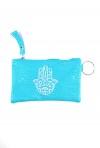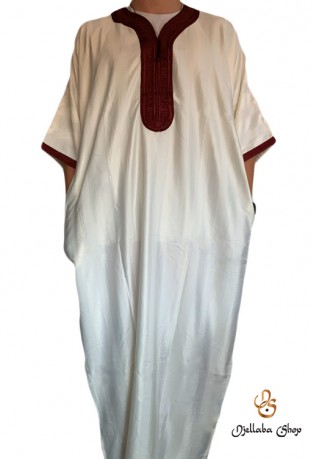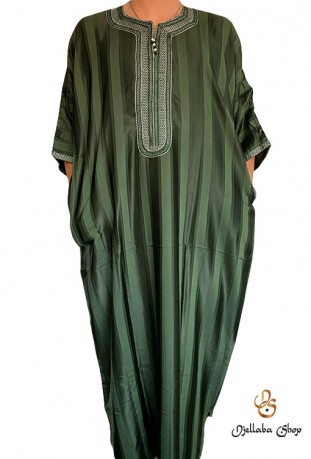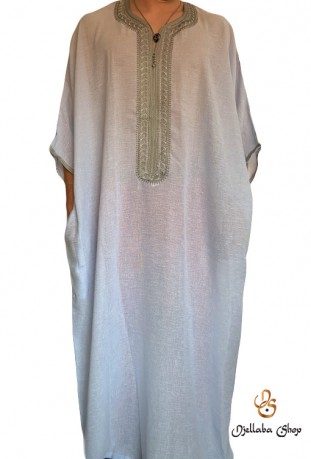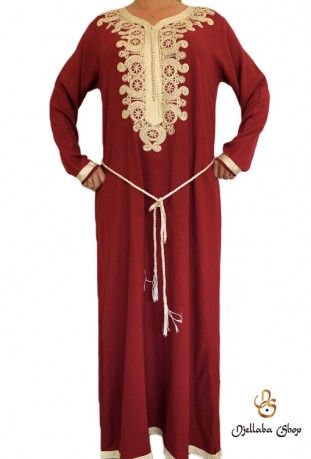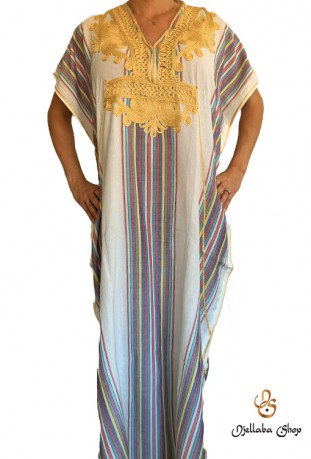-
 Français (French)
Français (French) -
 English (English)
English (English) -
 Español (Spanish)
Español (Spanish) -
 Deutsch (German)
Deutsch (German)
No products
caftan There are 6 products.
The Moroccan caftan is a symbol of Moroccan identity and is composed of high-end dresses, the most famous of which is the hand-woven Fassi brocade dress, more precisely in Fez and Marrakech to sew the Moroccan caftan, in addition to the velvet dress, the Moroccan jewel dress, silk dresses and others, and extends to the ankle, and takes the form ...
The Moroccan caftan is a symbol of Moroccan identity and is composed of high-end dresses, the most famous of which is the hand-woven Fassi brocade dress, more precisely in Fez and Marrakech to sew the Moroccan caftan, in addition to the velvet dress, the Moroccan jewel dress, silk dresses and others, and extends to the ankle, and takes the form of a djellaba with a lookout Without headgear and collar, open from the front, either along its length or towards the bottom belt area, in the middle of it are the weaves and akkad, which are among the most important characteristics of the Moroccan caftan. It is embroidered with many types of Moroccan models such as Fassi embroidery, which are models in which gold and silver threads are used.
And also the numeral or ribati models, the Fassi account models, the zigzag models of Tetouan, the models of Chefchaoui and the Zamuri style. To date, the festive outfit is undisputed by any other outfit. Among the most well-known Moroccan caftans is the Al-Nat' caftan, which is a luxurious Moroccan caftan of royal green velvet dress embroidered with golden natta patterns and worn by the bride with the golden enclosure and Moroccan ornaments on henna night, which is considered a ritual of Moroccan wedding rituals. , in addition to the Khrib caftan woven from the brocade dress The yellow, which is a basic piece of the bride's dress or the jewel dress is called al-Kharib because its price is high and ruins the family budget.
Men's Caftan
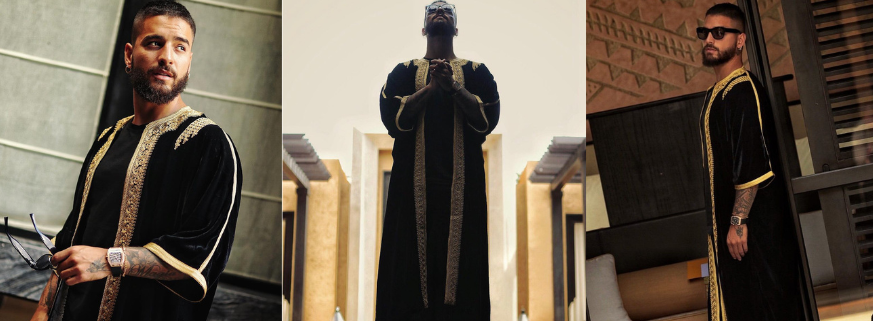
The Makhzani or royal caftan, which is another Moroccan caftan, is characterized by its wide and loose cuts, and the Moroccan royal family plays an important role in its preservation. While in the north of the Morocco We find the Kaftan Hajj Omar, which the bride wears, especially with the severity of Tetouan and Tangier. In the Souss, the Asmal caftan is considered the basis of the Sousse dress. There are also other types of Moroccan caftans, such as the brightly colored Al-Bahja brocade caftan, and the Rabat caftan woven from a red and green purple velvet dress with gold embroidery.
Women's Caftan
Moroccan caftan was not limited to being a traditional Moroccan garment in the wardrobe of Moroccan women at occasions and weddings, as the caftan industry experienced strong growth and increased demand after Moroccan designers and designers brought it to international forums, where it attracted attention in the fashion capital Anwaro, Paris and Fashion Week in Turkey and Abu Dhabi as well as Brussels ... The Moroccan caftan was on the throne of the biggest fashion brands in the world, and was even worn by celebrities and international personalities, which whetted the appetite of Western fashion designers such as; Balmain, Yves Saint Laurent, Jean Paul Gaultier and others who rushed to include improved versions in their catalogues, reflecting Moroccans' love and appreciation for beauty, and their ability to preserve a historical legacy in a society that has gone through different eras and civilizations.
Moroccan caftan accounts for 16% of Moroccan handicraft exports and it should be noted that Morocco organizes a number of annual gatherings to celebrate Moroccan caftan, including the Marrakech Festival for Moroccan caftan, which is the largest international event at the caftan forum, which has reached its twenty-third session and is attended by international fashion designers to discover the new Moroccan caftam made of Moroccan vineyards.
The difference between the Moroccan caftan and the Ottoman caftan
The Moroccan caftan is a symbol of Moroccan identity and authentic Moroccan heritage and differs in origin and shape from the Ottoman caftan, which was an open coat on the front worn over clothing and this was confirmed by Turkish researcher and Dr. Mufidah Abdlnor Kassir in his famous book Historical Development of the Caftan Costume. In which she pointed out that the term caftan was used to refer to any long and loose dress, regardless of its origin and shape, and some civilizations were distinguished by a type of caftan whose forms differed from one country to another. Description of the Moroccan caftan:
《 usuallywears Moroccan caftans, Moroccan dress Both in men and women, and by people of the upper and middle class, it is sometimes called the dafina (the undercut of the Moroccan takchita) in Morocco. It is a long, plump garment, similar to an overcoat around the waist with an embroidered fabric belt, the belt or Medhamah, who locks up the caftan and carries a silver dagger, without which men are rarely seen. The garment has a round neckline with or without a fixed collar and slits at the side seams. The opening on the front is closed by several nails and small golden rings or a knot. The sleeves are straight and long. The caftan is usually made of cotton, silk, wool or velvet fibers and is the most commonly used silver garment or thread. The dresses are of all colors, usually dark. The edges of the caftans are embroidered with gold. The caftan fits around the hip area and covers the entire body.
Traditional Moroccan clothing composed of Moroccan caftan
The Moroccan caftan represents an authentic and central Moroccan outfit, from which it branched out and was inspired by many traditional Moroccan costumes since ancient times, including:
Mansouriya
A purely Moroccan dress, whose origins date back to the Moroccan sultan Al-Mansur Al-Dhahabi, who is considered the first to invent and wear a dress in the name of Al-Mansuriya. Al-Mansuriya is considered a form of Moroccan caftan, as it consists of two pieces of Moroccan caftans, the bottom made of a thick dress and the top made of a transparent dress.
Takchita
A Moroccan dress consisting of two pieces: Al-Dafina is a Moroccan caftan and the Fawqiah is an open Moroccan caftan adorned with Moroccan patterns and embroidery and the teacher's service.
- Moroccan Takchita: Himma and Shan
- White Moroccan Takchita
- Married on Amariah in Moroccan takchita
Voltage intensity
The Shadda of Tetouan consists of the Moroccan caftan Hajj Omar and the fassi brocade belt or medhamah, a dense traditional Moroccan ornament, including the necklace "Johar", the "Labba", "Al-Khalayel" and "Al-Kharsa" and it covers Al-Tetounieh covered her hair with the cover of "Al-Sabnia d Al-Kanboush" or "Al-Sabnia d Al-Bahr" and diffuses it with "Al-Usbah" and finally adds "Pickleah", which is considered the dress of princesses in Morocco. Shadda is also worn in Tangier and differs from Tetouan in the form of head jewelry, and the jewelry is also gold instead of silver. The distress of Al-Tetouan is an authentic tradition, as it is the bride's dress on her wedding night, and the girl's dress twice, as soon as she reaches the age of seven or on the first day of her fast, the Holy Ramadan
Jawhar dress or fantasy dress
The "garment of Jawhar" comes from the "Caftan Daw al-Sabah" or "Al-Kharib" is tightened at her waist by a Fassi belt, so that the back of the bride is not affected by all the weight that arrives, above him the famous Caftan fassi "Al-Kharib", which was the specialty of the Ben Sharif factories in Fez.
- The dress, Dr. Al-Jawhar, in the light morning caftan
The intensity with the parr or dress of the Chaouénite presence
The Shawnee dress consists of a Moroccan caftan of the type of Hajj Omar Gallaba and a wide belt in silk or brocade, and the "Al-Haraz" which is an elegant band of the embroidered white dress, and the "Al-Suwaisa" is a silk scarf worn under the "Al-Haraz" and is characterized by a ruffle that hangs from its sides. In addition to the "Jawhar Knights" costume. And the Chaouen woman wears the famous Moroccan Charbel. A traditional dress of the city of Chefchaouen worn by the morskis during the "Hadra", a musical art in Morocco reserved for women, where they meet many times inside homes and nooks and crannies to perform rituals of remembrance, praise and blessing of God through prayers of a Sufi character.
Tenue souss
La robe des femmes de la région amazighe du souss La robe de la femme amazighe , avec la robe du docteur Al-Jawhar Al-Fassi, l'intensité tétouane et la takchita blanche, est la robe la plus importante de la mariée marocaine dans toutes les parties du Royaume du Maroc, et il se compose du Kaftan Ismal. La tutelle qui est portée sur le caftan Asmal en plus du qatayeb et de l'edal et des bijoux amazighs d'al-Susi.
Grand kiswa ou barbisca
L'habit des Juifs du Maroc , qui les distinguait du reste des Juifs d'Afrique du Nord et des pays du Maghreb , qui montre le chant de la mode marocaine depuis l'Antiquité. Cette robe a été confectionnée à Tétouan, c'est une robe en velours ou en soie de couleurs noir, rouge, violet, vert et bleu, brodée de motifs Al-Nat'a Al-Fassi.
Subcategories
Caftan womens
The Moroccan caftan is a traditional costume of Moroccan women, considered one of the oldest traditional garments in the world, and its appearance dates back to the Moroccan sultan Ahmed Al-Mansour Al-Dhahabi. It is a symbol of nobility, elegance, heritage and identity in Morocco, especially on happy occasions such as weddings, henna and circumcision.
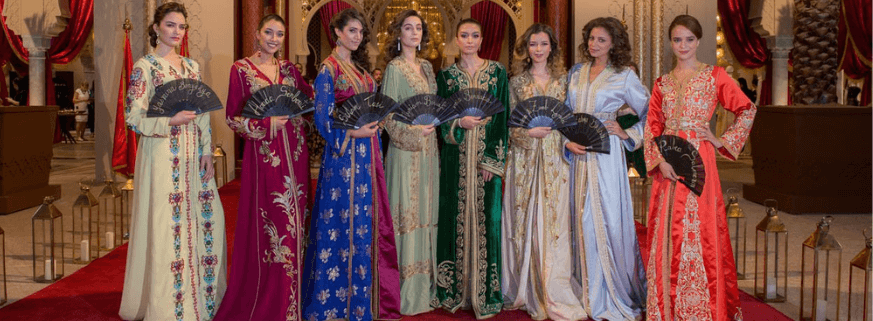
The history of the Moroccan caftan
The Moroccan caftan is considered one of the oldest traditional clothes, as its appearance dates back to the Merinid period, then to the Saadian era, especially during the reign of the Moroccan sultan. Ahmed Al-Mansour Al-Dhahabi. Then it spread to Andalusia, according to some researchers, thanks to the Iraqi musician "Zaryab" in Ottoman costume at the beginning of the ninth century, which will encourage Moroccans to export thousands of pieces of Moroccan clothing (caftan). to the King of Portugal, who was in love with this dress. The caftan is also considered a special dress for the Moroccan people, expressing a culture and aesthetic of a high level, emphasizing its position in front of other peoples. It is a symbol of the customs and traditions of every Moroccan person, and a distinct fashion that appears in each caftan. Its know-how and origins are well mastered, because there is no doubt about the admiration of international designers for the specificity and aesthetics of the Moroccan caftan, and their influence on it in a certain way over the years, hence the Moroccan caftan has spread to neighboring countries and they have been impressed by the know-how offered by the Moroccan manufacturer until today, We see the Moroccan caftan in the world.
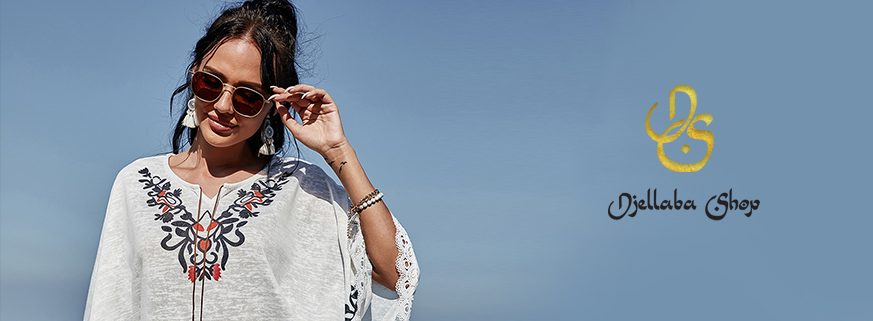
Description of the Moroccan caftan
The Moroccan caftan is the essential piece for Moroccan women at every wedding, party or special occasion.
The Moroccan caftan is made on luxurious fabrics that are decorated with handmade Moroccan embroideries such as Rabati (relating to the city of Rabat) or El Fassi (relating to Fez), in addition to decorating it with stones, without forgetting the most important process, it is what is called in Morocco "the service of the master" compared to craftsmen who spin silk threads, silver or gold .
Moroccan Men's Caftan
It's like a djellaba without a headgear, and it's also superior to it in terms of the quality of the dresses and the abundance and brilliance of the silk embroidery, making it often worn at weddings and parties.
The world fame of the caftan
Moroccan Caftan
The caftan was originally a Persian dress reserved for men, then it moved to the Ottomans and from there to the Maghreb.Due to the proximity to Morocco, some traditional Moroccan clothing generally resembles Algerian clothing, especially the Moroccan caftan, which is distinguished by its quality compared to its affordable price, Unlike the dear Algerian caftan, Algerian artist Fella recorded a song in the Moroccan caftan in 2009.
Moroccan Caftan in the world
Among the international designers who have also been conquered by the Moroccan caftan are Kenzo, John Paul Gaultier and Christian Lacroix, who have attracted the attention of women from multiple cultures, geographies and nationalities, who have brought the beauties of the world to wear the Moroccan caftan, among them we quote the late Elizabeth Taylor, the late Whitney Houston and the singer. Mariah Carey, actress Susan Sarandon, Turkish Tuba Yuekston, and artists Haifa Wehbe, Assala Nasri, Mayada El Hennawy, Diana Haddad, Nawal Al Zoghbi and Sherine Abdel Wahab, not to mention former White House Lady and former US Secretary of State Hillary Clinton. During one of his visits to Morocco.
Men's caftan
It's like a djellaba without a headgear, and it's also superior to it in terms of the quality of the dresses and the abundance and brilliance of the silk embroidery, making it often worn at weddings and parties. Moroccan sultans wore the Moroccan caftan, but today this dress has become more associated with Moroccan women.
The Moroccan caftan
The Moroccan men's caftan is a traditional costume of Moroccan men and women , considered one of the oldest traditional clothes in the world belonging to Moroccans It dates back to the twelfth century at the time of the Almohad dynasty in Morocco. It is considered a symbol of nobility, elegance, heritage and identity in Morocco, especially on happy occasions such as weddings, henna and circumcision.
The origins of the Moroccan caftan date back to the twelfth century AD at the time of the Almohad dynasty, when the sultans of the Almohad dynasty sought a majestic outfit worthy of the status of Moroccan sultan. Where Fez was considered the first industrial city in the world in the year 600 AH corresponding to 1203 AD, because of the laboratories and factories of weaving clothes, of which the Moroccan caftan was manufactured. Leo Africanus says in his book Description of Africa about the city of Fez:In Fez, there are five hundred and twenty houses for weavers, which are many buildings with many layers and spacious rooms like palace halls. Each room includes a large number of linen weavers. There are also one hundred and fifty spinning mills for wool shorts, most of which are located next to the river. »

The 12th century Moroccan caftan was dark in color with short sleeves, on which men wore a piece of black or dark-colored wool called bernos. The front of the bronchi was shorter than the back to make it easier to walk or horseback riding. He had a cap or headgear that provided warmth in the winter. Also, the djellaba with babush was very popular with Moroccan menThe Moroccancaftan is the habit of the Merinid and Moroccan sultans since the fifteenth century
In the Merinid era in Morocco, the Moroccan caftan became the habit of the Moroccan sultans par excellence and during the fifteenth century AD, that is to say corresponding to the Wattassi era in Morocco, the Moroccan caftan was a feminine habit in Fez, as Leo the African describes it in his book " And the dress of women is beautiful, except that on hot days they are just a shirt. They bind it with a belt that is not free of ugliness, and in winter they wear wide-sleeved clothes sewn from the front, like men's clothes.
And it was the custom of the inhabitants of Fez to present the Moroccan caftans with the emblem of the bride in the Wattsian era, which Moroccans still want to preserve. Historian Ibrahim Harkat states: "It is customary for three to show up. caftans, three dresses, several shirts, a sherbella (Moroccan sandal) and decorative bedspreads and pillows, eight mattresses and four embroidered pillows placed next to the trays, as well as a rug, three bedspreads and other things. The woman's apparatus incurred exorbitant expenses for the average man that would soon impoverish him, but the bride's father would bear it exponentially. This indicates how much Moroccan caftan is linked to Moroccan culture.
Moroccan dress Al-Mansuriya inspired by the Moroccan caftan
In the Saadian era in Morocco, this dress will be known for the first time under the name of "Al - Mansuriya" in connection with the Moroccan sultan Al-Mansur Al-Dhahabi , who made especially for him in Fez, a piece of this dress and attributed to his name of a thick dress and the meta is a transparent Moroccan caftan. The historian Ahmed bin Khaled Al-Nasiri says in his book "The investigation of the news of the countries of the Far Maghreb". "The garment called Al-Mansuriyah, which is a piece of file, was not used before him, and it was the first to be invented and added to it, which is why it was said Al-Mansuriyyah. As historian Ibrahim Harkat mentioned in Sultan Saadi's robe:《Al-Mansur adopted a special robe, in which he inserted the caftan and Al-Mansuriyyah attributed to him, and he was the first to use Al-Mansuriyyah in his clothes, and this robe was adopted by kings and jurists after him.
The Moroccan caftan in the Alawite era
The kings and sultans of the Alawite state took care of their appearance and elegance, so the caftan was part of their clothes intended to appear on occasions and festivals that took place in the palace. The historian
of the Alawite state and the captain of its supervisors, "Mawlay Abd al-Rahman bin Zidan", mentions in his book that the Alawite sultans kept caftans made of the dress in wooden boxes and veneered.
The caftan of Moroccan women in the seventeenth century was a loose garment made of wool or velvet or any color and covered the whole body, but it was opened from the neck and this style had a collar or line at the waist, and the edges of the caftan were embroidered with gold threads. In addition, the caftan was tied with wide silk and gold belts that surrounded the waist. The Moroccan caftan was worn by the bride during the wedding ceremony in Morocco.
In the eighteenth century, the Moroccan women's caftan became the length of the ankle, open only on the side, and its shape changed into a long-sleeved shirt similar to a coat, usually made of wool, velvet or cotton, attached to a belt that the Moroccan woman puts around her waist.
During the nineteenth century, the traditional caftans of Moroccan women are now in museums. Some of them are in the museum of the Oudayas in Rabat and were seen by researchers in September 1977. All caftans were open at the front and held by numerous akkad buttons and small loops, and had side slots. In addition, they had a belt that went around the waist. The belt was made of brocade in the form of a silver or gold thread. Moroccan women wore a " charbella" special in velvet or Moroccan leather and embroidered with gold threads. Also, women Moroccan women used the veil or veil to cover their faces with this traditional caftan.
The modern Moroccan caftan
The traditional Moroccan caftan retains its place in Moroccan society on traditional occasions, such as the caftan al-Nata' al-Fassi and the henna caftan on henna night in Moroccan wedding rituals, and the caftan al - kharib, which is still worn with the fassi dress and the caftan of Hajj Omar, the basis of Tetouanism and Tetouanism. As for the modern Moroccan caftan, it is worn mostly in "dating" and family and religious occasions, because Moroccan women had more freedom to design their Moroccan caftan according to their taste. and modern styles, and in the middle are Al-Akkad, Al-Safifa and Al-Damamah This is considered the most important feature of the Moroccan caftan among other caftans. It is decorated with Moroccan motifs (Al-Nat' Fassi, Rabati motifs, Tetouan zigzag motifs, Fassi al-Hisab motifs, Chauni motifs ..) and the cultivation of precious stones, weights, garnets and the service of signs

